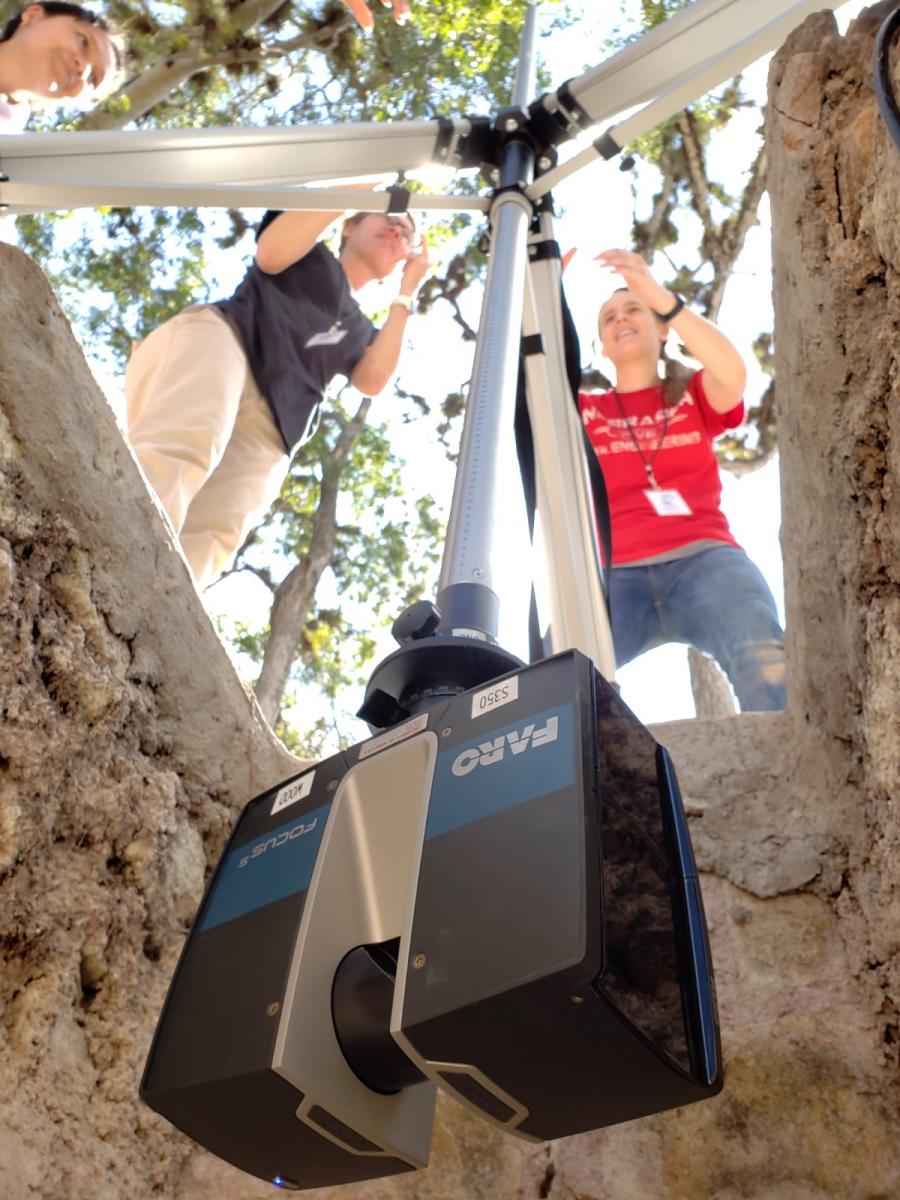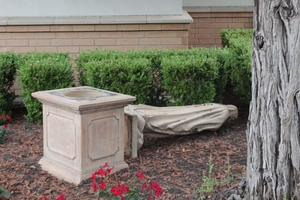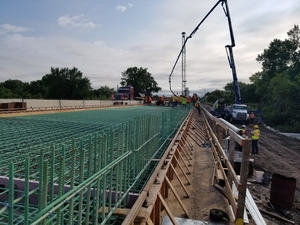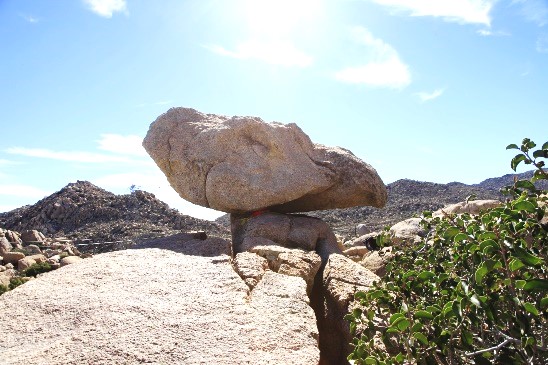Active Research Projects
RAPID: Performance of Agricultural Storage Silos and Farm Bins in Nebraska and Iowa During the August 2020 Derecho
 |
Overview: This project will provide the critical data necessary to answer the following fundamental research questions, without which agricultural and rural communities will continue to be devastated by high wind events with little recourse: 1) How do the foundation type, anchorage depth (if present), and baseplate design influence the wind resistance of agricultural storage silos and farm bins? This question is critical to advance fundamental knowledge of structural performance and to understand how to design more resilient systems. 2)How can the probability of failure for agricultural storage silos and farm bins be represented as a function of wind speed? This question is critical to advance fundamental knowledge of structural vulnerability and identify regions in need of mitigation. PI and co-PIs: Christine Wittich Sponsor: National Science Foundation Duration: September 2020 - August 2021 Products: Pending. |
Resilience of Rural Transportation Networks to Hazards
 |
Overview: Despite the importance of rural areas to the national transportation network and the national economy, rural transportation has several unique challenges hypothesized to lower resilience to future hazards compared to its urban counterparts. The primary objective of this project is to quantify the functionality restoration of bridges and roadways in rural areas in the aftermath of non-natural and other hazards, such that the resilience of rural transportation networks can be studied and ultimately enhanced. PI and co-PIs: Christine Wittich Sponsor: U.S. Department of Transportation via Mid-America Transportation Center (MATC) Duration: September 2020 - February 2022 Products: Pending. |
Rescuing Rosalila: Remote Sensing
 |
Overview: The UNL research team will perform detailed (high-resolution) lidar scans for the tunnels directly associated with Rosalila in the interior of Structure 16 in the Copan Archaeological Park at Copan Ruinas, Honduras. This work includes detailed scanning of the tunnels using a tripod with high-dynamic range settings (for improved colors) at various positions and elevations to minimize occlusion in ornately detailed (exposed) areas of the exterior of Rosalila PI and co-PIs: Richard Wood (PI, UNL Civil and Environmental Engineering), Heather Richards-Rissetto (co-PI, UNL Anthropology) and Christine Wittich (co-PI) Sponsor: Copan Asociacion (Honduras) Duration: July 2020 - August 2021 Products: Pending. |
Lidar-Based Vibration Monitoring for Assessing Safety of Damaged Bridges
 |
Overview: There is a critical need for high-quality engineering data to be collected efficiently during routine bridge inspections and following unanticipated loads (e.g., vehicular collision). The primary objective of this project is to develop a methodology for acquiring vibration measurements using terrestrial laser scanners and to develop an algorithm to extract key engineering data from these measurements, such that improved structural health information can be utilized for decision-making. PI and co-PIs: Christine Wittich (PI) and Richard Wood (co-PI, UNL Civil and Environmental Engineering) Sponsor: U.S. Department of Transportation via Mid-America Transportation Center (MATC) Duration: March 2020 - December 2021 Products: Pending. |
REU Site: Sustainability of Horizontal Civil Networks in Rural Areas
|
Overview: The objectives of this REU site are: 1) provide research experiences to undergraduate students with at least 60% of participants from institutions with limited research opportunities, at least 50% from groups underrepresented in engineering, and at least 40% first-generation college students; 2) provide participants with first-hand exposure to the engineering and infrastructure challenges facing the rural United States through research and professional development opportunities; and 3) promote and sustain the interest of undergraduate students in persisting in a STEM field and pursuing graduate education. PI and co-PIs: Shannon Bartelt-Hunt (PI, UNL Civil and Environmental Engineering) and Christine Wittich (co-PI) Sponsor: National Science Foundation (NSF) Duration: March 2020 - February 2024 Products (as PI): Products (as Faculty Mentor):
|
Seismic Vulnerability of Historic Monuments
 |
Overview: Recent earthquakes have highlighted the vulnerability of many historic structures and monuments – the collapse of which can result in permanent loss of cultural heritage. Many historic structures, particularly monuments and statues, can be classified as systems of freestanding structures. It is the primary objective of this project to correlate the probability of failure of freestanding structures (e.g. collapse) to earthquake intensity. This will be accomplished by rigorous numerical modeling and probabilistic assessments. PI and co-PIs: Christine Wittich (PI) and Ece Erdogmus (co-PI, UNL Durham School) Sponsor: National Park Service (NPS) Duration: August 2019 - December 2020 Products: Pending |
Impact of Contact and Interface Modeling on Precarious Rock Fragilities (Phase 1 and Phase 2)
|
|
Overview: The long-term research goal is to reduce epistemic uncertainty in the probabilistic overturning predictions for precariously balanced rocks. Recent field surveys of precarious rocks have highlighted the potential for complex interface conditions that are not readily captured by traditional surveying techniques. As a result, the overall objective of phase 1 of this project is to quantify and assess the impact of interface geometric variations on the probabilistic overturning predictions of precarious rocks through numerical modeling. Building upon this, the objective of phase 2 of this project is to conduct experimental shake table testing for validation. PI: Christine Wittich Sponsor: United States Geologic Survey (USGS) via the Southern California Earthquake Center (SCEC) Duration: February 2019 - January 2021 Products:
|
Traffic-Induced Vibration and Phased Construction Bridges
 |
Overview: The primary objective of this research is to determine the amplitude and duration of traffic-induced vibration that results in unacceptable levels of deterioration for phased construction bridge decks. To address this, field monitoring of bridges during construction will measure the typical ranges of traffic-induced vibration, which will serve as the input during laboratory experimentation to quantify the relationship between that vibration and the durability of the bridge deck. PI and co-PIs: Christine Wittich (PI), Richard Wood (co-PI, UNL CIVE), and George Morcous (co-PI, UNL Durham School) Sponsor: Nebraska Department of Transportation (NDOT) Duration: July 2019 - May 2021 Products: Pending |
Data Driven Predictions of Bridge Scour
|
Overview: Bridge scour is a leading cause of bridge closures and failures in the country and in Nebraska. Scour conditions require continuous monitoring by individual inspectors at the county and state levels to prioritize bridges for intervention and mitigation. The objective of this project is to develop empirical scour predictions for Nebraska bridges and a data-driven prioritization scheme for intervention and new bridge design. PI and co-PIs: Richard Wood (PI, UNL CIVE), Christine Wittich (co-PI), Chung Song (co-PI, UNL CIVE), and Junke Guo (co-PI, UNL CIVE) Sponsor: Nebraska Department of Transportation (NDOT) Duration: July 2019 - December 2021 Products: Pending |
Precariously Balanced Rock Fragility Validation
 |
Overview: Precariously balanced rocks are one of the few ways to place realistic constraints on rare seismic hazard. However, the prediction of precariously balanced rock response is highly uncertain. This project aims to understand the impact of various techniques in field surveying and assumption in numerical modeling on the resulting seismic hazard conclusions. PI: Christine Wittich Sponsor: Pacific Gas & Electric (PGE) Duration: November 2018 - June 2021 Products:
|
Establishment of an Outdoor Laboratory and Testbed for Bridge Health
 |
Overview: This project has one overarching objective to transform two bridge sites into a national research and educational facility for bridge health and testing. This will permit access for nondestructive evaluation and destructive test verifications. Furthermore, it is sought to leverage this facility for future research projects and identify strategic directions for this first-of-its kind facility on realistic aging infrastructure. This involves using decommissioned and under-used steel and concrete bridge structures in Nebraska. PI and co-PIs: PI - Richard Wood (UNL CIVE); co-PIs - Christine Wittich, Joshua Steelman, Jinying Zhu, Daniel Linzell (UNL CIVE) and Jay Puckett (UNL Durham School) Sponsor: Nebraska Department of Transportation (NDOT) Duration: July 2019 - December 2021 Products: Pending |
Smart big data pipeline for Aging Rural bridge Transportation Infrastructure (SMARTI)
 |
Overview: This large, multi-institution project focuses on aging rural bridge networks. The research team will combine existing and new datasets to address challenges of relevance to bridge owners using scalable and replicable big data pipeline components. Dr. Wittich's role in this project involves the use of lidar (laser) scanning for monitoring the condition of aging bridges over time, as part of the Sensor Action team. See the project website: https://bridgingbigdata.github.io/pages/partners.html PI and co-PIs: Robin Gandhi (UN-Omaha), Deepak Khazanci (UN-Omaha), Brian Ricks (UN-Omaha), Chungwook Sim (UNL CIVE), Daniel Linzell (UNL CIVE) Senior Personnel: UNL CIVE: Ron Faller, Laurence Rilett, Chung Song, Christine Wittich, Richard Wood, Jinying Zhu; UNL Electrical Engineering: Hamid Sharif; UNL Biological Systems Engineering: Wayne Woldt; UNL Durham School: Jay Puckett; University of Nebraska-Omaha: Parvathi Chundi, Kate Cooper, Prithviraj Dasgupta, Matthew Germonprez, Sachin Pawaskar, Jon Youn, Christian Haas. Sponsor: National Science Foundation Duration: September 2018 - September 2021 Products: Pending |